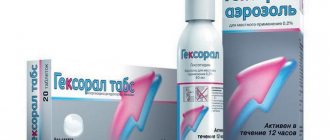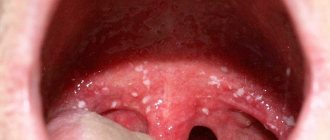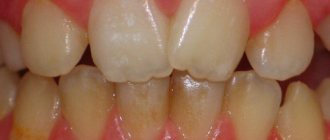Diseases of the ENT organs belong to the most common category of pathologies occurring in patients of any gender and age. This is due to the heavy load and vulnerability of the ear, nose and throat systems. Inflammation of the mucous membranes of the larynx and vocal cords caused by a cold or infectious disease is called laryngitis.
The inflammation has an acute or chronic course and is characterized by severe symptoms - pain, dryness, a feeling of a “lump” in the throat, bouts of “barking” cough, hoarseness or loss of voice. As the pathology develops, the mucous membrane swells, which is very dangerous in childhood due to the small lumen of the larynx. This is fraught with the development of false croup (obstruction of the upper respiratory tract) in children.
Causes of laryngitis
Inflammation of the larynx most often occurs as a complication of a viral or cold disease, or an infectious disease - scarlet fever, whooping cough, measles, tuberculosis, staphylococcal, streptococcal infections, etc. Laryngitis rarely develops in isolation; usually inflammation of the larynx occurs against the background of diseases of other ENT organs - rhinitis, pharyngitis, tracheitis or bronchitis.
Inflammation can be triggered by prolonged inhalation of polluted air, chemicals, smoking, alcohol abuse, overstrain of the vocal cords and gastroesophageal reflux, etc. The most dangerous is laryngitis of an allergic nature, as a result of which pathological swelling and destruction of the respiratory tract can occur.
Pathology can be caused by contact with infected infectious diseases, trauma or damage to the larynx, or surgical intervention on the respiratory system. Inflammation often occurs when exhaling cold air for a long time or consuming cold foods or drinks, which often happens in children and adults on hot days.
Clinical picture
As a rule, pathology manifests itself gradually. At first there are no symptoms. Subsequently, weakness, malaise, and possible fever are noted.
Unpleasant sensations occur in the larynx area. These are pain, burning, tickling, tickling and dryness. Afterwards a cough is registered, at first it is dry, then a copious amount of productive sputum appears. It may contain mucus, as well as admixtures of pus and sometimes blood.
As a result, the larynx becomes very inflamed, swollen, and becomes bright red. The voice shrinks, becomes hoarse, low and sometimes can disappear completely.
Symptoms of the disease
Laryngitis begins with sharp intense pain, soreness and a feeling of a “lump” in the throat. It is difficult and painful for the patient to speak, the voice becomes hoarse. Against the background of hyperemia of the larynx, difficulties with swallowing and breathing may occur. As the disease progresses, symptoms of intoxication appear - headache, fever, chills, weakness. Inflammation is accompanied by a convulsive, hysterical cough that does not bring relief, during which a large amount of sputum is released, sometimes mixed with pus.
Symptoms of laryngitis
Laryngitis can appear suddenly against a background of general good condition or with minor discomfort. A person's body temperature may be normal or slightly elevated. Next comes a feeling of some burning, scratching, and increased dryness in the throat. The appearance of painful swallowing is not always observed. First of all, changes or disturbances in a person’s voice are observed, the nature of the voice becomes hoarse, and its usual sound and lightness are lost. When examining the larynx, its hyperemia is noted, inflamed vessels form purple spots on the mucous tissue, characteristic thickening or incomplete closure of the vocal cords.
In early childhood, laryngitis is especially intense. This is due to the fact that due to swelling of the mucous membrane, the access of air to the larynx is blocked - “false croup”, leading to a disruption of the inhalation mechanism. In children, breathing begins to be accompanied by noise, causing them anxiety and irritation. Due to a lack of oxygen supply to the child’s body, brain function may be disrupted, even leading to coma. In children This condition requires urgent hospitalization.
Treatment of the disease
Treatment procedures will vary depending on the cause of the disease. All patients, and especially children, are prescribed bed rest, complete rest of the vocal cords, plenty of warm drinks, gargling, and inhalations. Local medications are prescribed; for bacterial diseases, antibiotics; for allergies, antihistamines.
For severe coughs, antitussive drugs and agents that increase sputum production are recommended. If there is purulent-serous plaque on the walls of the larynx and vocal cords, the doctor will irrigate and wash the walls with medications. Physiotherapeutic procedures are very effective - ultraviolet irradiation, laser therapy, magnetic therapy, electrophoresis, etc.
Treatment of acute laryngitis takes 7-10 days and does not cause complications. If adequate therapy is not available, the disease can become chronic with constant exacerbations, or lead to dangerous complications.
When the first symptoms of inflammation of the larynx appear, you should immediately seek qualified help. Otolaryngologists at the Hayde Clinic will conduct a qualified examination and prescribe effective treatment for laryngitis and its complications, which will help you quickly get rid of unpleasant and painful symptoms and return to a full life. You can make an appointment by phone: 8 (812) 322-93-07, 8 (812) 611-08-26.
Acute laryngitis
Acute laryngitis is an acute inflammation of the mucous membrane of the larynx and vocal cords, caused by a bacterial or viral infection or resulting from irritation by gases, chemicals, etc. It may also affect the deeper tissues of the larynx (cartilage). Most often, acute laryngitis is one of the manifestations of ARVI.
Classification
— Catarrhal laryngitis is the mildest form of the disease, which is characterized by redness of the throat, pain, and a slight increase in temperature.
- Hypertrophic laryngitis - with it, growths form on the ligaments, which can go away on their own over time. It is because of them that the voice becomes hoarse. If the nodules do not go away on their own, they are cauterized with silver nitrate or removed surgically.
- Atrophic laryngitis - with it, thinning of the inner mucous membrane of the larynx appears, the cough is dry and painful, the voice is hoarse, and when coughing, crusts streaked with blood may come out.
- Occupational laryngitis - occurs from systematic overstrain of the throat. It goes away on its own or with the help of treatment; if the overexertion continues, the voice may become hoarse forever.
— Diphtheria laryngitis is characterized by the spread of infection from the tonsils down the throat, while a white coating in the form of a membrane forms on the mucous membrane. Coughing can release it and cause airway blockage and death. The same membrane can also appear with streptococcal infection.
— Tuberculous laryngitis occurs with pulmonary tuberculosis. Nodular thickenings form in the tissues of the larynx, and destruction of the laryngeal cartilage and epiglottis is possible.
— Syphilitic laryngitis is one of the complications of syphilis. At the second stage of this disease, ulcers and plaques form on the mucous membrane, at the third stage - scars that deform the larynx and vocal cords. The outcome is complete hoarseness.
FORMS
- Acute catarrhal laryngitis is a superficial inflammation of the mucous membrane of the larynx.
- Edematous-infiltrative laryngitis is manifested by swelling of the laryngeal tissues, the leading symptoms are shortness of breath and difficulty breathing.
- Phlegmonous laryngitis is a purulent lesion of the submucosal layer of the larynx, spreading to the adjacent tissues of the neck.
- Chondroperichondritis of the larynx is a serious disease, inflammation spreads to the cartilage of the larynx.
- A localized form of acute laryngitis is a laryngeal abscess (a limited abscess, most often located on the epiglottis - the cartilage that closes the entrance to the larynx).
Chronic laryngitis appears as a result of frequent acute laryngitis or other diseases in which the nose, sinuses, and pharynx suffer and become inflamed.
Symptoms of acute laryngitis
- The main symptom is hoarseness up to aphonia (lack of a sonorous voice).
- Dry throat.
- Soreness, scratching in the throat.
- Dry barking cough.
- Sore throat or neck that may get worse when swallowing or talking.
- Enlargement and tenderness of the submandibular and cervical lymph nodes.
- There may be a deterioration in general well-being, weakness, an increase in body temperature, most often not higher than 37.5 ° C. In severe forms, an increase in body temperature to 39-40 ° C and a pronounced deterioration in health are possible.
- Other symptoms of ARVI may be present - runny nose, nasal congestion.
- Edematous laryngitis is characterized by: shortness of breath, a feeling of a lump in the throat.
- Phlegmonous laryngitis and laryngeal abscesses (purulent forms of laryngitis) are characterized by severe pain in the throat and swallowing disorders (choking, including liquid food).
Incubation period
From several hours to several days.
Causes
- Contact with a patient with ARVI.
- Hypothermia of the whole body or individual parts (head, legs, etc.).
- Inhaling cold air.
- Infectious diseases, for example, influenza (an acute viral disease, characterized by severe intoxication - weakness, fatigue, aching muscles and joints, headache, increased body temperature to 39-40 ° C), whooping cough (acute airborne bacterial infection, the most characteristic a sign of which is a paroxysmal spasmodic cough) and others.
- Inhalation of irritants (caustic or hot fumes, heavily dusty air).
- Entry into the larynx of a foreign body (for example, a fish bone).
- Overstrain of the vocal folds (strong screaming, prolonged loud speech, especially in the cold).
- Smoking, alcohol abuse.
- Spread of infection from neighboring organs (nose, paranasal sinuses, tonsils, teeth).
- Gastro-esophageal reflux (GERD) – in this case, acidic stomach contents are refluxed into the esophagus, resulting in irritation of the mucous membrane of the larynx. Manifested by heartburn, belching.
- Allergy.
- The presence of chronic diseases and decreased immunity contribute to the development of the disease.
Diagnostics
- Analysis of complaints and medical history: is there any concern about hoarseness, sore throat or neck, shortness of breath; how long ago these complaints appeared, whether their appearance was preceded by hypothermia, contact with a patient with ARVI, vocal stress.
- General inspection. When externally palpated, the larynx may be painful, and the lymph nodes are often enlarged. In severe forms of laryngitis, inflammation can spread to the tissues of the neck, which is manifested by swelling and redness.
- Examination of the larynx (laryngoscopy) is performed using a laryngeal mirror or special laryngeal endoscopes. Pay attention to the color of the mucous membrane (in acute inflammation it is usually red), the presence of swelling, mucus or pus in the larynx, the width of the glottis (is there difficulty breathing), impaired mobility of the larynx, the presence of limited abscesses protruding into the lumen of the larynx.
Differential diagnosis should be made with the following diseases: parainfluenza and adenoviral acute laryngeal stenosis, laryngeal tonsillitis, acute rhinitis (measles, herpetic, diphtheria, influenza), bronchial asthma, retropharyngeal abscess, laryngeal papillomatosis, epiglottitis, congenital stridor, etc.
Treatment of acute laryngitis
- First of all, the patient is recommended to limit the vocal load, preferably complete vocal rest. It is better to speak in a calm, quiet voice; whispering is contraindicated, since with whispered speech the load on the larynx is higher.
- It is recommended to exclude hot, cold, spicy, salty foods, and alcohol from the diet.
- It is recommended to refrain from smoking.
- It is advisable to humidify the air in the room.
- Inhalations with antibacterial and anti-inflammatory drugs are prescribed. Inhalations with alkaline mineral water are effective.
- In the office of an otolaryngologist, medications are infused into the larynx with a special laryngeal syringe.
- If necessary, antibiotics are prescribed (if a bacterial infection is attached or initially occurs) - Suprax, Azithromycin, Sumamed, Cephalexin, Flemoclav. Often, instead of systemic therapy or in addition to it, treatment is carried out with local drugs (Bioparox), sulfonamides (Biseptol) or inhaled antibiotics (Fluimucil-antibiotic).
- Physiotherapy, for example, electrophoresis (movement of drug particles under the influence of an electric field).
- Treatment of edematous, phlegmonous laryngitis, chondroperichondritis and laryngeal abscesses, as well as complicated forms and laryngitis, accompanied by the development of laryngeal stenosis (narrowing of its lumen and disruption of the passage of air into the respiratory tract), is carried out in a hospital.
- For edematous laryngitis, decongestant, antiallergic, and hormonal drugs are prescribed.
- In an emergency situation when suffocation develops, a tracheotomy is performed (an incision in the skin and underlying tissues on the neck and insertion of a breathing tube into the trachea).
- Laryngeal abscesses are opened surgically, usually under local anesthesia.
Complications and consequences
- Transition to chronic form.
- In severe forms of laryngitis or allergic swelling of the larynx, suffocation may develop.
- Purulent forms of laryngitis can lead to the development of severe complications: phlegmon of the neck - diffuse purulent inflammation of the tissues of the neck;
- mediastinitis - inflammation of the mediastinum (the space in the middle parts of the chest cavity);
- sepsis – spread of infection through the blood throughout the body;
- Lung abscess - the formation of a cavity with pus in the lung.
Prevention of acute laryngitis
- Prevention of ARVI: avoid hypothermia, drafts;
- healthy lifestyle (walking in the fresh air, playing sports, etc.);
- hardening;
- avoid contact with ARVI patients;
- use personal protective equipment (masks, gauze bandages, respirators) when in contact with ARVI patients.
Treatment of angioedema of the larynx.
Treatment of angioedema consists of two stages. The first is emergency care, the second is hospital treatment. Before starting treatment, the cause of angioedema is determined, and then a treatment regimen is prescribed. This may include:
- taking antihistamines (“Suprastin”, “Loratadine”, “Tavegil”);
- corticosteroid drugs (for example, Prednisolone, Dexamethasone, Nasonex, Celeston);
- diuretics (for example, Furosemide);
- enterosorbents for removing allergens and toxins (for example, Multisorb);
- enzyme preparations (“Pancreatin”, “Festal”);
- administration of a C1 inhibitor, a blood protein whose deficiency leads to non-allergic angioedema;
- administration of fresh frozen plasma (for non-allergic edema);
- administration of androgens - sex hormone preparations (for non-allergic edema).
Diagnosis and treatment of laryngitis
A pediatric otolaryngologist is involved in the diagnosis and treatment of laryngitis in children. For acute sore throat, treatment should begin as quickly as possible.
The doctor conducts a detailed diagnosis of laryngitis, which includes:
- general inspection and collection of complaints;
- endoscopic examination of ENT organs;
- general blood and urine tests;
- if necessary, bacteriological examination of the discharge;
- Ultrasound of soft tissues of the neck, spirography and ECG as indicated.
For catarrhal laryngitis, anti-inflammatory and antibacterial sprays are prescribed; for purulent forms, antibiotics are prescribed for oral administration.
Sometimes, with chronic laryngitis or complications, surgical treatment may be required (if drug therapy is ineffective).
Treatment methods
In the case of laryngitis, therapeutic measures must be comprehensive. Patients, according to the form of the pathology, are prescribed medications, inhalations, physiotherapy, also bed rest and warm, abundant fortified drinks.
It is necessary to avoid straining the vocal cords; it is forbidden to eat hot, cold, or spicy food. To correct dry air, it is useful to use a humidifier.
To speed up the healing process, it is necessary to increase the body's defenses. For this purpose, vitamins, immunomodulators and a delicate balanced diet are prescribed.
First aid for Quincke's edema.
How to relieve Quincke's edema? The first thing you should do when you find yourself next to a person with signs of angioedema is to call an ambulance.
What to do in case of Quincke's edema before the doctors arrive?
- First, unbutton the patient's clothes, loosen the tie, remove chains, beads, etc., thereby ensuring air flow. If you are indoors, open a window to let fresh air in.
- Make the patient more comfortable and try to calm him down by saying that doctors will arrive soon and begin treatment. This condition puts the patient into shock, which only worsens respiratory failure.
- If the problem began due to contact with an allergen, eliminate it if possible.
- Give the patient a tablet of any antihistamine that is in your home medicine cabinet. If the person cannot swallow, crush the tablet and place it under the person's tongue.
- Give the patient food more often if he can swallow, preferably with mineral water.
- If swelling is caused by contact with an allergen, give the patient activated carbon, Enterosgel or Polysorb to reduce the concentration of the allergic substance in the body.
- The patient's feet should be kept warm. You can place them in a bath of warm water or wrap them well.
- Place any vasoconstrictor drops into the patient's nose.
- It is necessary to measure the patient's blood pressure, and if it falls below 90, it is necessary to administer adrenaline to the patient.
Even if the patient feels better as a result of the measures provided, under no circumstances should one refuse medical care.
Causes of laryngeal edema.
In addition to knowing about the first signs of angioedema, you need to understand why, in principle, this dangerous condition can arise.
Typically, angioedema is of an allergic nature, but there are cases when the human body is affected not by allergens, but by other external factors.
The most common causes of angioedema of the larynx are:
- certain foods (for example, eggs, chocolate, etc.);
- plant pollen during the flowering period;
- fungi;
- household chemicals;
- taking medications;
- insect bites;
- dust;
- pet hair or excretions;
- exposure to open sun;
- hypothermia;
- stressful situations;
- digestive problems;
- heredity.
Inhalations
To moisturize the mucous surface and eliminate unpleasant symptoms of laryngitis, inhalations are prescribed. They are carried out using traditional methods and pharmaceutical preparations.
Most often, manipulations are done with saline solution, essential oils, mucolytics, hormonal, anti-inflammatory and decongestant agents. Infusions and decoctions of medicinal herbs and alkaline mineral waters are also used.
The procedure can be carried out using a special device, or in the usual way at home. Its duration should not exceed 15 minutes in one approach.
Laryngitis in children
In children, laryngitis develops very quickly. Often the disease manifests itself suddenly: the baby has difficulty breathing, wheezing, and the temperature rises. The child gets scared, breathes quickly and shallowly, and the skin around the mouth may turn blue. Parents should immediately consult a doctor for advice and assessment of the severity of the condition. Laryngitis can be dangerous for infants and preschool children. Children often develop a special form of the disease against the background of infectious diseases of the respiratory tract - false croup, or acute obstruction of the respiratory tract. It entails swelling of the mucous membrane of the larynx and spasm of the glottis. As a result, air access is blocked and frightening attacks of suffocation occur. They usually happen at night, and completely unexpectedly: the baby wakes up in fear, cries, wheezes, breathes noisily and coughs hysterically. If such alarming symptoms occur, you should immediately call an ambulance or take the child to the hospital, because false croup is a risk of respiratory arrest. Most often, this complication develops in children with exudative diathesis (skin lesions due to food allergies or pseudo-allergic reactions).
1.General information
Laryngeal edema is a life-threatening condition that manifests itself as obstruction of the upper respiratory tract and, in the case of severe asphyxia, can be fatal.
Like other local edema, laryngeal edema is an accumulation of fluid in the intercellular space, as a result of which the tissue swells and increases in size, and the air lumen, accordingly, narrows. In contrast to the spasm of the larynx described on our website (see), which in most cases resolves quite quickly, swelling of the larynx can persist for a long time; any tendency towards its progression requires emergency medical attention.
Obviously, local laryngeal edema cannot be considered an independent disease - it is always a consequence of some process, reaction or condition. In general, there are many reasons, which explains the relatively high incidence of laryngeal edema in clinical practice.
A must read! Help with treatment and hospitalization!
Drug treatment
To combat infections that act as the main cause, antibiotics are indicated. Medicines are used as prescribed by a doctor. Mainly attributed to drugs from the groups of macrolides, penicillins and cephalosporins. The duration of the course of therapy is determined by a specialist based on clinical data.
Symptomatic medications are prescribed:
- Antiseptics - Ingalipt, Septolete, Faringosept. Available in aerosol and tablet form.
- Antitussives and expectorants - Aflubin, Brombexin, Travisil.
- Vitamin complexes. All groups of vitamins are used, but especially ascorbic acid.
- Essential oils, saline solution and dry raw materials of medicinal plants for inhalation.
The main drugs in the treatment of laryngitis are:
- Berodual - used at the beginning of the disease, when there are no obvious signs. Helps liquefy and remove mucus. Used as a spray or in a nebulizer system.
- Lizobakt - has a pronounced antiseptic effect. Available in tablet form for adults and children.
- Lugol - has some irritating and bactericidal effects, helps fight the causes of pathology and eliminates unpleasant symptoms.
- Pulmicort is an excellent remedy with strong anti-edematous properties. More often used in pediatric practice to prevent swelling of the pharynx.
- Hexoral is a drug with a wide spectrum of therapeutic action. Has antimicrobial and antifungal effect. Used in the form of syrup or spray to irrigate a sore throat.
How to relieve throat swelling with laryngitis
The main complication of laryngitis is false croup or laryngospasm. The condition is dangerous, especially if the attack occurs in a child. If laryngospasm develops, you must call an ambulance.
At the pre-medical stage, the following rules must be followed:
- During an attack, it is important not to panic; against the background of this condition, the spasm will worsen even more. If a child is having a seizure, he needs to be picked up and calmed down as quickly as possible.
- If you have laryngospasm, you should not lie down; it is better to sit or stand on your feet. In an upright position, the airways open better.
- Ventilate the room, go out onto the balcony if possible, if there is no frost.
- Alkaline drinking relieves spasms well for children and adults. For this, it is best to use Borjomi or Esentuki mineral water. If water is not at hand, you should heat the milk, add a pinch of soda and drink in small sips.
- Inhalations with a nebulizer with alkali or saline are effective for swelling of the larynx. If you don’t have a nebulizer, you can simply go into the bathroom, open the hot water and breathe in the steam.
If you have an antihistamine at home (Suprastin, Tavegil, Eden) and antispasmodics (Drotaverine, No-shpa), you can take these medications according to the patient’s age and weight. Antihistamines will remove reactive edema and prevent its further development. Antispasmodics will relieve spasms, thereby improving patency in the organ. Despite the criticality of the situation, it is impossible to exceed the permissible dose in order to avoid an overdose.
Inhalation with a nebulizer.









